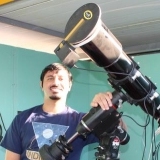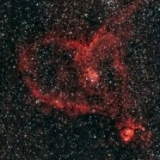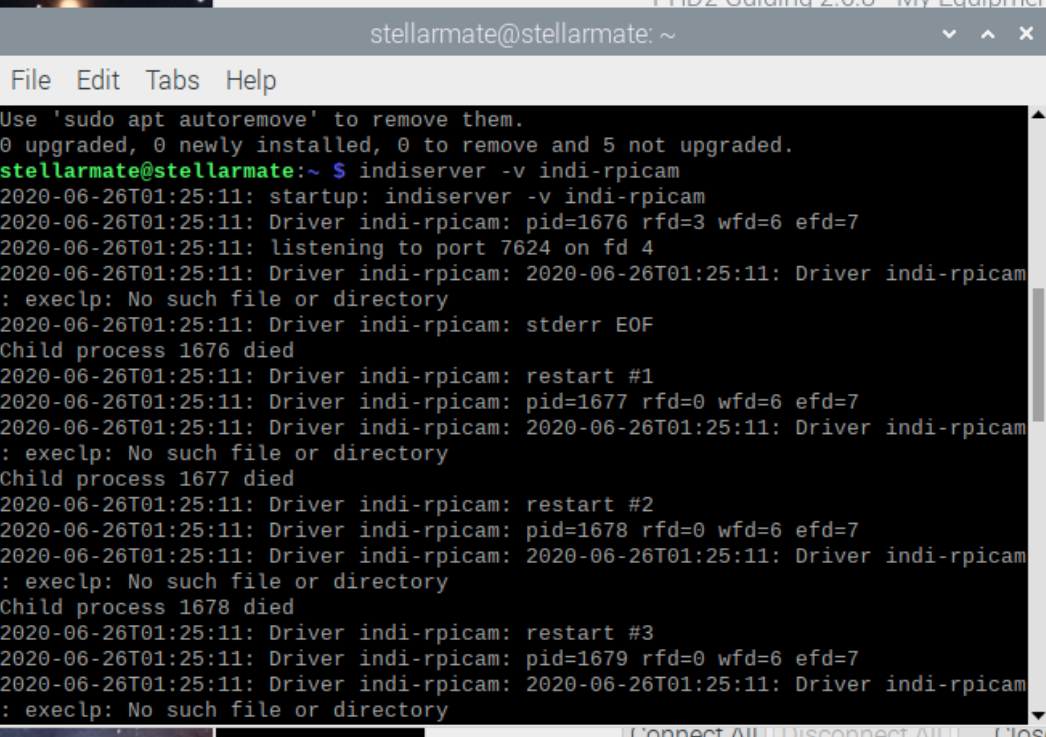×
INDI Library v2.0.7 is Released (01 Apr 2024)
Bi-monthly release with minor bug fixes and improvements
Driver for Raspberry Pi "High Quality Camera?"
- Lars Berntzon
-

- Offline
- Senior Member
-

- Posts: 49
- Thank you received: 12
Replied by Lars Berntzon on topic Driver for Raspberry Pi "High Quality Camera?"
Ive uploaded a new file now that kind of sort of works actually: github.com/lboclboc/indi_raspistill/rele...V0.1/indi_raspistill
3 years 11 months ago
#54101
The topic has been locked.
- James McPherson
-

- Offline
- New Member
-

- Posts: 5
- Thank you received: 0
Replied by James McPherson on topic Driver for Raspberry Pi "High Quality Camera?"
How does one install this driver into Astroberry? I searched the Readme and if it's there, I'm not bright enough to find it.
-Jim
-Jim
3 years 10 months ago
#56037
The topic has been locked.
- James McPherson
-

- Offline
- New Member
-

- Posts: 5
- Thank you received: 0
Replied by James McPherson on topic Driver for Raspberry Pi "High Quality Camera?"
I compiled the driver, but when I start it with "indiserver -v indi_raspistill" I get this error:
execlp: No such file or Directory
... driver indi_raspistill: stderr EOF
Any ideas?
execlp: No such file or Directory
... driver indi_raspistill: stderr EOF
Any ideas?
3 years 10 months ago
#56042
The topic has been locked.
- Jasem Mutlaq
-

- Away
- Administrator
-

Replied by Jasem Mutlaq on topic Driver for Raspberry Pi "High Quality Camera?"
This driver is now available in StellarMate:
sudo apt-get update && sudo apt-get -y install indi-rpicam
sudo apt-get update && sudo apt-get -y install indi-rpicam
The following user(s) said Thank You: James McPherson
3 years 10 months ago
#56051
The topic has been locked.
- Jose Corazon
-

- Offline
- Supernova Explorer
-

- Posts: 1119
- Thank you received: 182
Replied by Jose Corazon on topic Driver for Raspberry Pi "High Quality Camera?"
In reading this post, I came across this website:
astronomy.robpettengill.org/astroRPi.html
The quality he was able to coax out of the rpicam back in 2016 blows my mind. Look at the image he got of Jupiter and compare that to the result he got with a ZWO. The new 12 MP camera should easily be on par then.
astronomy.robpettengill.org/astroRPi.html
The quality he was able to coax out of the rpicam back in 2016 blows my mind. Look at the image he got of Jupiter and compare that to the result he got with a ZWO. The new 12 MP camera should easily be on par then.
3 years 10 months ago
#56057
The topic has been locked.
- James McPherson
-

- Offline
- New Member
-

- Posts: 5
- Thank you received: 0
Replied by James McPherson on topic Driver for Raspberry Pi "High Quality Camera?"
The topic has been locked.
- James McPherson
-

- Offline
- New Member
-

- Posts: 5
- Thank you received: 0
Replied by James McPherson on topic Driver for Raspberry Pi "High Quality Camera?"
I didn't figure out why I couldn't enable it from the command line, but I was able to enable it from the INDI Control Panel and then open PHD2 and start streaming images to it.
Is it still a 1 second limit for the exposures?
-Jim
Is it still a 1 second limit for the exposures?
-Jim
Last edit: 3 years 10 months ago by James McPherson. Reason: Updated information.
3 years 10 months ago
#56070
The topic has been locked.
- Lars Berntzon
-

- Offline
- Senior Member
-

- Posts: 49
- Thank you received: 12
Replied by Lars Berntzon on topic Driver for Raspberry Pi "High Quality Camera?"
Ok, seems the actual binary is missing for some reason. Ill have a look at it.
3 years 10 months ago
#56083
The topic has been locked.
- Lars Berntzon
-

- Offline
- Senior Member
-

- Posts: 49
- Thank you received: 12
Replied by Lars Berntzon on topic Driver for Raspberry Pi "High Quality Camera?"
Yes, there should be no HW-limit to that 1sec as far as I know but the documentation for this camera is very sparse. Ill keep trying to increase the time.
3 years 10 months ago
#56084
The topic has been locked.
- Jasem Mutlaq
-

- Away
- Administrator
-

Replied by Jasem Mutlaq on topic Driver for Raspberry Pi "High Quality Camera?"
The binary is not missing, it should be
not indi-rpicam. This is why you can use KStars/PHD2 to start it since the binary is correct there.
indiserver -v indi_rpicamnot indi-rpicam. This is why you can use KStars/PHD2 to start it since the binary is correct there.
The following user(s) said Thank You: Lars Berntzon, James McPherson
3 years 9 months ago
#56091
The topic has been locked.
- James McPherson
-

- Offline
- New Member
-

- Posts: 5
- Thank you received: 0
Replied by James McPherson on topic Driver for Raspberry Pi "High Quality Camera?"
It's remarkable how much better things work when you type the right commands. I've got it working on both platforms now, but like that I had a good excuse to buy Stellarmate.
Thanks for the help! I'm excited to see what this little camera can do as a guide scope and as a planetary imaging camera.
-Jim
Thanks for the help! I'm excited to see what this little camera can do as a guide scope and as a planetary imaging camera.
-Jim
3 years 9 months ago
#56126
The topic has been locked.
Replied by Rashed on topic Driver for Raspberry Pi "High Quality Camera?"
I was planning to invest in a guide camera and was think the pi Hq cam would be a good option.
Was wondering what your experience is with this sensor?
I see the driver is not piggybacked on raspstill but natively use MMAL. How long does it take to process a 1 second exposure? Also I noticed a fixme comment on the source code for exposures longer than 1 sec. May I ask what is the limitarion with that?
The pi hq cams are all out of stock atm, with stock expected later next week I believe. Any feedback would be appreciated wrt guiding.
Was wondering what your experience is with this sensor?
I see the driver is not piggybacked on raspstill but natively use MMAL. How long does it take to process a 1 second exposure? Also I noticed a fixme comment on the source code for exposures longer than 1 sec. May I ask what is the limitarion with that?
The pi hq cams are all out of stock atm, with stock expected later next week I believe. Any feedback would be appreciated wrt guiding.
3 years 8 months ago
#57919
The topic has been locked.
Time to create page: 1.235 seconds
© 2003-2022 by INDI Library. All rights reserved.

